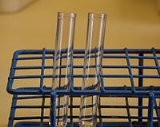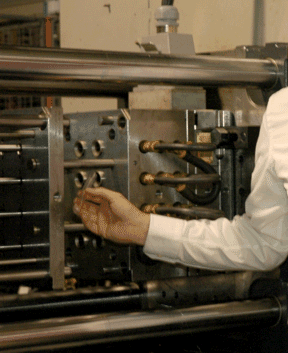
Test tube
Encyclopedia
A test tube, also known as a culture tube or sample tube, is a common piece of laboratory glassware
consisting of a finger-like length of glass
or clear plastic
tubing, open at the top, usually with a rounded U-shaped bottom.
A large test tube designed specifically for boiling liquids is called a boiling tube
.
Test tubes are available in a multitude of lengths and widths, typically from 10 to 20 mm wide and 50 to 200 mm long. The top often features a flared lip to aid pouring out the contents; some sources consider that the presence of a lip is what distinguishes a test tube from a culture tube. Some test tubes have a flat bottom; some are made so as to accept a ground glass stopper
or a screw cap. They are often provided with a small ground glass
or white glaze area near the top for labeling with a pencil.
s to hold, mix, or heat small quantities of solid or liquid chemicals, especially for qualitative experiments and assays. Their round bottom and straight sides minimize mass loss when pouring, make them easier to clean, and allow convenient monitoring of the contents. The long, narrow neck slows down the spreading of vapors and gases to the environment.
A test tube filled with water and upturned into a water-filled beaker
is often used to capture gas
es, e.g. in electrolysis
demonstrations.
Culture tubes are often used in biology
for handling and culturing all kinds of live organisms, such as molds, bacteria
, seedling
s, plant cuttings, etc.; and in medicine
and forensics
to store samples of blood
or other fluids.
A test tube with a stopper
is often used for temporary storage of chemical or biological samples.
Test tubes are usually held in special-purpose racks, clamp
s, or tongs. Some racks for culture tubes are designed to hold the tubes in a nearly horizontal position, so as to maximize the surface of the culture medium inside.
Test tubes are sometimes put to casual uses outside of lab environments, e.g. as flower vases or containers for spice
s.
 Test tubes for physics and chemistry are usually made of glass for better resistance to heat and corrosive chemicals and longer life. Tubes made from expansion-resistant glasses, such as borosilicate glass
Test tubes for physics and chemistry are usually made of glass for better resistance to heat and corrosive chemicals and longer life. Tubes made from expansion-resistant glasses, such as borosilicate glass
, can be placed directly over a Bunsen burner
flame.
Culture tubes for biology are usually made of clear plastic (such as polystyrene
or polypropylene
) by injection molding
and are often discarded after use.
Test tubes may come with prepared contents. For example, a blue top tube is a test tube of 5 ml containing sodium citrate
as an anticoagulant, used to collect specimens for coagulation screen
s and testing for glucose-6-phosphate dehydrogenase
.
Laboratory glassware
Laboratory glassware refers to a variety of equipment, traditionally made of glass, used for scientific experiments and other work in science, especially in chemistry and biology laboratories...
consisting of a finger-like length of glass
Glass
Glass is an amorphous solid material. Glasses are typically brittle and optically transparent.The most familiar type of glass, used for centuries in windows and drinking vessels, is soda-lime glass, composed of about 75% silica plus Na2O, CaO, and several minor additives...
or clear plastic
Plastic
A plastic material is any of a wide range of synthetic or semi-synthetic organic solids used in the manufacture of industrial products. Plastics are typically polymers of high molecular mass, and may contain other substances to improve performance and/or reduce production costs...
tubing, open at the top, usually with a rounded U-shaped bottom.
A large test tube designed specifically for boiling liquids is called a boiling tube
Boiling tube
frame|A boiling tube looks much like a test tube.A boiling tube is a small cylindrical vessel used to strongly heat substances in the flame of a Bunsen burner...
.
Test tubes are available in a multitude of lengths and widths, typically from 10 to 20 mm wide and 50 to 200 mm long. The top often features a flared lip to aid pouring out the contents; some sources consider that the presence of a lip is what distinguishes a test tube from a culture tube. Some test tubes have a flat bottom; some are made so as to accept a ground glass stopper
Ground glass joint
Ground glass joints are used in laboratories to quickly and easily fit leak-tight apparatus together from commonly available parts. For example, a round bottom flask, Liebig condenser, and oil bubbler with ground glass joints may be rapidly fitted together to reflux a reaction mixture...
or a screw cap. They are often provided with a small ground glass
Ground glass
Ground glass is glass whose surface has been ground to produce a flat but rough finish.Ground glass surfaces have many applications, ranging from mere ornamentation on windows and table glassware to scientific uses in optics and laboratory glassware....
or white glaze area near the top for labeling with a pencil.
Uses
Test tubes are widely used by chemistChemist
A chemist is a scientist trained in the study of chemistry. Chemists study the composition of matter and its properties such as density and acidity. Chemists carefully describe the properties they study in terms of quantities, with detail on the level of molecules and their component atoms...
s to hold, mix, or heat small quantities of solid or liquid chemicals, especially for qualitative experiments and assays. Their round bottom and straight sides minimize mass loss when pouring, make them easier to clean, and allow convenient monitoring of the contents. The long, narrow neck slows down the spreading of vapors and gases to the environment.
A test tube filled with water and upturned into a water-filled beaker
Beaker
Beaker may refer to:* Beaker , a beverage container* Beaker , or "laboratory beaker", a glass object used for holding fluids and chemicals in a laboratory setting.* Beaker , a prehistoric drinking vessel...
is often used to capture gas
Gas
Gas is one of the three classical states of matter . Near absolute zero, a substance exists as a solid. As heat is added to this substance it melts into a liquid at its melting point , boils into a gas at its boiling point, and if heated high enough would enter a plasma state in which the electrons...
es, e.g. in electrolysis
Electrolysis
In chemistry and manufacturing, electrolysis is a method of using a direct electric current to drive an otherwise non-spontaneous chemical reaction...
demonstrations.
Culture tubes are often used in biology
Biology
Biology is a natural science concerned with the study of life and living organisms, including their structure, function, growth, origin, evolution, distribution, and taxonomy. Biology is a vast subject containing many subdivisions, topics, and disciplines...
for handling and culturing all kinds of live organisms, such as molds, bacteria
Bacteria
Bacteria are a large domain of prokaryotic microorganisms. Typically a few micrometres in length, bacteria have a wide range of shapes, ranging from spheres to rods and spirals...
, seedling
Seedling
thumb|Monocot and dicot seedlingsA seedling is a young plant sporophyte developing out of a plant embryo from a seed. Seedling development starts with germination of the seed. A typical young seedling consists of three main parts: the radicle , the hypocotyl , and the cotyledons...
s, plant cuttings, etc.; and in medicine
Medicine
Medicine is the science and art of healing. It encompasses a variety of health care practices evolved to maintain and restore health by the prevention and treatment of illness....
and forensics
Forensics
Forensic science is the application of a broad spectrum of sciences to answer questions of interest to a legal system. This may be in relation to a crime or a civil action...
to store samples of blood
Blood
Blood is a specialized bodily fluid in animals that delivers necessary substances such as nutrients and oxygen to the cells and transports metabolic waste products away from those same cells....
or other fluids.
A test tube with a stopper
Stopper (plug)
A bung is truncated cylindrical or conical closure to seal a container, such as a bottle, tube or barrel. Unlike a lid which encloses a container from the outside without displacing the inner volume, a bung is partially inserted inside the container to act as a seal...
is often used for temporary storage of chemical or biological samples.
Test tubes are usually held in special-purpose racks, clamp
Clamp (tool)
A clamp is a fastening device to hold or secure objects tightly together to prevent movement or separation through the application of inward pressure...
s, or tongs. Some racks for culture tubes are designed to hold the tubes in a nearly horizontal position, so as to maximize the surface of the culture medium inside.
Test tubes are sometimes put to casual uses outside of lab environments, e.g. as flower vases or containers for spice
Spice
A spice is a dried seed, fruit, root, bark, or vegetative substance used in nutritionally insignificant quantities as a food additive for flavor, color, or as a preservative that kills harmful bacteria or prevents their growth. It may be used to flavour a dish or to hide other flavours...
s.
Manufacture

Borosilicate glass
Borosilicate glass is a type of glass with the main glass-forming constituents silica and boron oxide. Borosilicate glasses are known for having very low coefficients of thermal expansion , making them resistant to thermal shock, more so than any other common glass...
, can be placed directly over a Bunsen burner
Bunsen burner
A Bunsen burner, named after Robert Bunsen, is a common piece of laboratory equipment that produces a single open gas flame, which is used for heating, sterilization, and combustion.- Operation:...
flame.
Culture tubes for biology are usually made of clear plastic (such as polystyrene
Polystyrene
Polystyrene ) also known as Thermocole, abbreviated following ISO Standard PS, is an aromatic polymer made from the monomer styrene, a liquid hydrocarbon that is manufactured from petroleum by the chemical industry...
or polypropylene
Polypropylene
Polypropylene , also known as polypropene, is a thermoplastic polymer used in a wide variety of applications including packaging, textiles , stationery, plastic parts and reusable containers of various types, laboratory equipment, loudspeakers, automotive components, and polymer banknotes...
) by injection molding
Injection molding
Injection molding is a manufacturing process for producing parts from both thermoplastic and thermosetting plastic materials. Material is fed into a heated barrel, mixed, and forced into a mold cavity where it cools and hardens to the configuration of the cavity...
and are often discarded after use.
Test tubes may come with prepared contents. For example, a blue top tube is a test tube of 5 ml containing sodium citrate
Sodium citrate
Trisodium citrate has the chemical formula of Na3C6H5O7. It is sometimes referred to simply as sodium citrate, though sodium citrate can refer to any of the three sodium salts of citric acid. It possesses a saline, mildly tart flavor. For this reason, citrates of certain alkaline and alkaline earth...
as an anticoagulant, used to collect specimens for coagulation screen
Coagulation screen
A combination of screening laboratory tests, designed to provide rapid non-specific information, which allows an initial broad categorization of haemostatic problems.The basic screen consists of:* platelet count* bleeding time for platelet function...
s and testing for glucose-6-phosphate dehydrogenase
Glucose-6-phosphate dehydrogenase
Glucose-6-phosphate dehydrogenase is a cytosolic enzyme in the pentose phosphate pathway , a metabolic pathway that supplies reducing energy to cells by maintaining the level of the co-enzyme nicotinamide adenine dinucleotide phosphate...
.

